Marstrand & Kyrkesund

Driving seaward from Kungälv we soon reached the lovely coastal town of Marstrand. Marstrand is another castle town (as you can see) and therefore also stands on a small island for defense. Unlike Kungälv, there is no bridge linking Marstrand to the shore so we got to take a ferry ride (I always like ferry rides), ableit it short one. It was only about 100 meters across the channel.
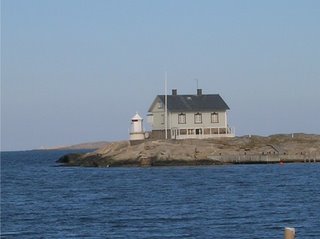 Once on the island, we scurried over to its seaward side. I HAD to see the open water. It had been months since I have been able to look out over saltwater stretching to the horizon and this deprivation is like denying me vitamin C, it is like a scurvy or somekind of withdrawl. How did I survive Beloit?
Once on the island, we scurried over to its seaward side. I HAD to see the open water. It had been months since I have been able to look out over saltwater stretching to the horizon and this deprivation is like denying me vitamin C, it is like a scurvy or somekind of withdrawl. How did I survive Beloit? 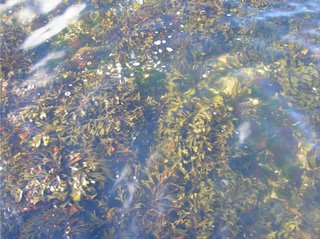 Added to the sound of waves surging along the seawall and the waft of seaweed (something that has only existed for me on grocery store shelves during recent months) gave me an intoxicatingly eurphoric pleasure that I could have floated upon up out over the water, joining the seagulls soaring over the harbor.
Added to the sound of waves surging along the seawall and the waft of seaweed (something that has only existed for me on grocery store shelves during recent months) gave me an intoxicatingly eurphoric pleasure that I could have floated upon up out over the water, joining the seagulls soaring over the harbor. 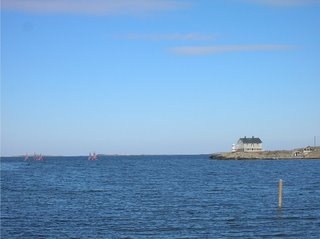 Then, just to tantalize me a little more with the call of the sea, there was a fleet of daring (and possibly cold-blooded) sailors out there beating back and forth off the point. Surely one of them needed a crew...
Then, just to tantalize me a little more with the call of the sea, there was a fleet of daring (and possibly cold-blooded) sailors out there beating back and forth off the point. Surely one of them needed a crew...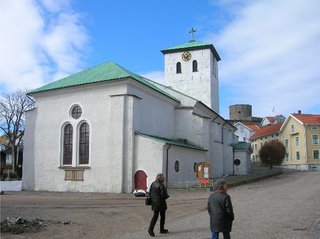 When the boats would not come closer, we gave up and wandered into the town again to explore Marstrand. The old church still stands prominently in the town below the castle.
When the boats would not come closer, we gave up and wandered into the town again to explore Marstrand. The old church still stands prominently in the town below the castle.
Ole and Annette in foreground.
 Now the castle itself is the subject of a most fantastic story of Tordenskjorld. He was a Danish naval officer who made a daring assault on this fortress and captured it in 1719. He had been sent to attack Göteborg, the biggest city in western Sweden, and inflict as much damage on the Swedish fleet as possible.
Now the castle itself is the subject of a most fantastic story of Tordenskjorld. He was a Danish naval officer who made a daring assault on this fortress and captured it in 1719. He had been sent to attack Göteborg, the biggest city in western Sweden, and inflict as much damage on the Swedish fleet as possible. When he made his attack on Göteborg he was quickly thrown back from the fortified city. Licked but not beaten, Tordenskjold took his forces north and attacked Marstrand. By dumb luck, the bulk of the Swedish Western Fleet was moored there, ready to move down and hem in any invader (Denmark) that seized Göteborg, thereby severing any supply lines.
Well, when the Swedes saw the approaching Danish warships with its soldiers already taking to the landing boats, the Swedish naval vessels--cornered in Marstrand--were scuttled to avoid capture. Then the out-numbered Swedish soldiers fled to the safety of the castle. Before long, Tordenskjold came ashore, set up his headquarters in a brothel, and delivered his terms.
When the Swedes refused to surrender, Tordenskjold and his small complement of troops settled in for a seige.
Meanwhile the Swedish King was enraged that Marstrand and the bulk of his Western Fleet had fallen so easily--virtually without a fight. Troops from Göteborg were immediately dispatched.
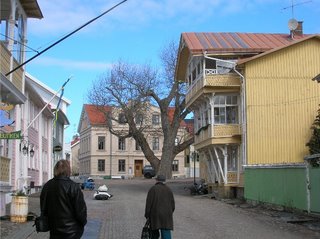 (The streets of Marstrand. This big oak tree in the square was probably standing when Tordenskjold marched through.)
(The streets of Marstrand. This big oak tree in the square was probably standing when Tordenskjold marched through.)Then, one evening Tordenskjold and his drummerboy marched up to the castle and very politely knocked on the door. Then he proceeded to invite his beseiged enemy down to the brothel to dine with him and discuss possible surrender terms. They agreed and as they came down the hill from the castle, Tordenskjold's troops lined the streets. (however, after they passed, the troops took off running down parallel streets and then stood waiting at the next intersection, thereby inflating the appearance of their numbers. After seeing this display of force, the defenders finally surrendered to Tordenskjold.
Thus, with a fairly small band of troops and one apparently intimidating drummerboy, Tordenskjold captured a major Swedish stronghold, sank half of Sweden's Western Fleet (and raised several of them and returned them to service--under Denmark--during the seige period), and captured hundreds of elite Swedish troops without hardly firing a shot. Naturally, Tordenskjold became national hero in Denmark (even though Swedish reinforcements from Göteborg drove him out of Marstrand just a few days after his victory). In fact, Tordenskjold brand matches (oddly enough, made in Sweden) with his portait on the box lid, are still readily available in almost all Danish grocery stores.
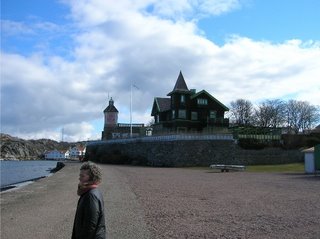 Annette standing in that wonderfully stiff sea-breeze blowing in off the Danish Straits.
Annette standing in that wonderfully stiff sea-breeze blowing in off the Danish Straits.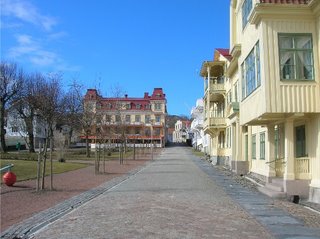 The Marstrand Hotel with its high, Victorian, hipped roofs. Also note the fancy balconies on the houses, probably one of the most defining architectural features of Marstrand. It really felt like New Orleans' French Quarter or the like.
The Marstrand Hotel with its high, Victorian, hipped roofs. Also note the fancy balconies on the houses, probably one of the most defining architectural features of Marstrand. It really felt like New Orleans' French Quarter or the like.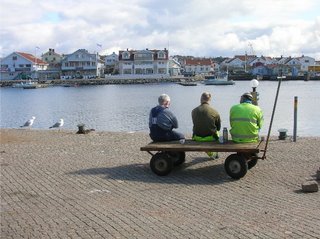 Then, as we prepared to move on we passed this spectacle which absolutely screams "Sweden." I only wish there had been three seagulls watching from the seawall to mirror these men sitting on a cart for their afternoon fika (coffeebreak). Like the British 4 o'clcok tea-time, Sweden grinds to a halt for a half hour during the morning and afternoon fika breaks.
Then, as we prepared to move on we passed this spectacle which absolutely screams "Sweden." I only wish there had been three seagulls watching from the seawall to mirror these men sitting on a cart for their afternoon fika (coffeebreak). Like the British 4 o'clcok tea-time, Sweden grinds to a halt for a half hour during the morning and afternoon fika breaks.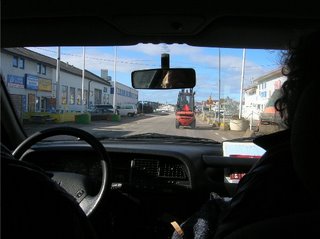 Well, our parking meter was running out and there was so much more to see on this coast. We hopped back in the car and followed a forklift out of town and made our way up the coast a little farther.
Well, our parking meter was running out and there was so much more to see on this coast. We hopped back in the car and followed a forklift out of town and made our way up the coast a little farther.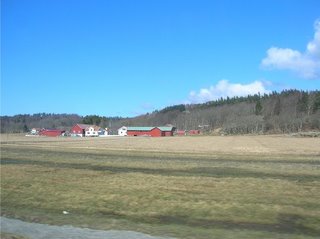 We drove inland first, retracing our steps up the peninsula before turning north and weaving through the coastal farmlands.
We drove inland first, retracing our steps up the peninsula before turning north and weaving through the coastal farmlands.
After a half hour or so we reached the wonderfully enchanting little fishing village of Kyrkesund...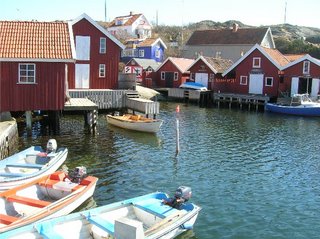 Kykesund is built entirely from the perspective of men who lived their lives on the sea. There is only one street into Krykesund--and it is a dead end at the harbor. This place was built for boats. The little harbor at the foot of the road is crammed with docks, storage sheds for nets and fish, and a fleet of little skiffs and run-abouts.
Kykesund is built entirely from the perspective of men who lived their lives on the sea. There is only one street into Krykesund--and it is a dead end at the harbor. This place was built for boats. The little harbor at the foot of the road is crammed with docks, storage sheds for nets and fish, and a fleet of little skiffs and run-abouts.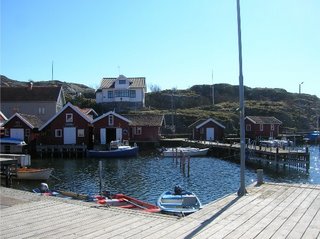 This was once the commercial cove in Kyrkesund where the fishermen stopped to unload or to take on nets and traps. Home--for the fishermen as well as their boats-- was actually on the other side of the harbor on a low, rocky island only accesible by boat.
This was once the commercial cove in Kyrkesund where the fishermen stopped to unload or to take on nets and traps. Home--for the fishermen as well as their boats-- was actually on the other side of the harbor on a low, rocky island only accesible by boat. Indeed, everything in Kykesund moved by boat. Here, the narrow channel that the town is built around opens to the archipelago and the open Danish Straits. The commercial cove is just to the left. To the right...
Indeed, everything in Kykesund moved by boat. Here, the narrow channel that the town is built around opens to the archipelago and the open Danish Straits. The commercial cove is just to the left. To the right...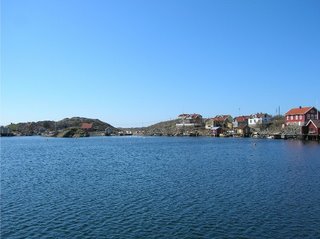 ...straight out from the end of the docks lies the opposite shore of the channel and the town itself. Then, panning further to the right...
...straight out from the end of the docks lies the opposite shore of the channel and the town itself. Then, panning further to the right...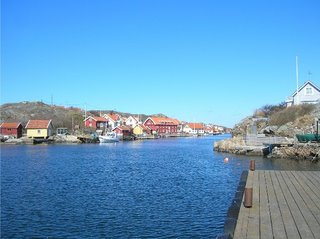 ...we can look up the narrow channel and see the heart of the town. Almost all the houses are over a century old as no new construction has been allowed here since the 1950s so as to preserve the village as it is. The fisherman's families still live here, though almost no one fishes anymore. Kykesund has become a summer community for a few lucky descendents of Sweden's bygone traditional fishery.
...we can look up the narrow channel and see the heart of the town. Almost all the houses are over a century old as no new construction has been allowed here since the 1950s so as to preserve the village as it is. The fisherman's families still live here, though almost no one fishes anymore. Kykesund has become a summer community for a few lucky descendents of Sweden's bygone traditional fishery.
Yet, they still move on the water. The only way across the channel is on the ferry (white hull on far shore).
 Every few hours, the ferry (with a schedule that is accurate to less than a minute) fires up and trundles across the channel with passengers, groceries, lumber, or whatever else needs to cross the little waterway.
Every few hours, the ferry (with a schedule that is accurate to less than a minute) fires up and trundles across the channel with passengers, groceries, lumber, or whatever else needs to cross the little waterway.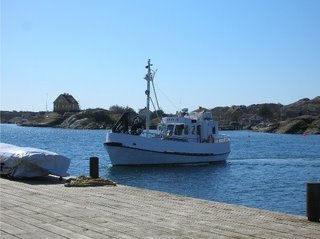 While Ole, Annette, and I sat easting lunch on the dock, the 2:13 ferry from Kyrkesund to Kyrkesund came putting over to drop off a few pasengers...
While Ole, Annette, and I sat easting lunch on the dock, the 2:13 ferry from Kyrkesund to Kyrkesund came putting over to drop off a few pasengers...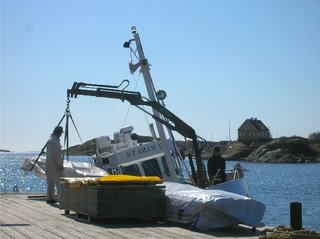
...and pick up a few sheets of plywood that damned near capsized the little craft. Frankly the hydraulic crane was probably overpowered for the little ferry.
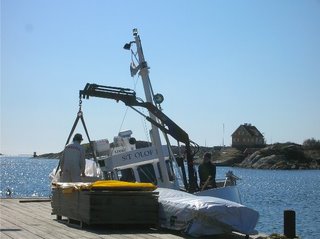
We watched with great amuseument as the boat heeled over, swung the load aboard, and then took off across the channel with a rather pronounced list to starboard.
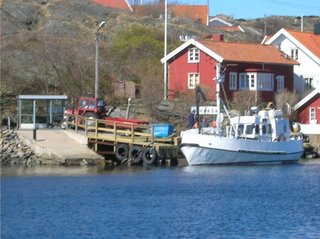 On the other side, the little St. Olof III (I can now guess the fate of St. Olof I and II) was greeted by a very pleased carpenter with an inordinately smokey red tractor.
On the other side, the little St. Olof III (I can now guess the fate of St. Olof I and II) was greeted by a very pleased carpenter with an inordinately smokey red tractor.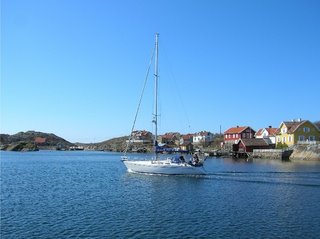 As we prepared to leave, a sailboat came through, proving the depth and navigatibility of the channel.
As we prepared to leave, a sailboat came through, proving the depth and navigatibility of the channel.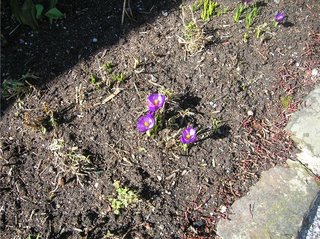 In the gardens of Kyrkesund, tucked behind the little houses perched along the rocks, the first irrefutable signs of spring were bursting forth.
In the gardens of Kyrkesund, tucked behind the little houses perched along the rocks, the first irrefutable signs of spring were bursting forth.Back on the road again, we clipped along past the countless lovely Swedish farms on our way south to Göteborg and the ferry that would take us to Denmark.
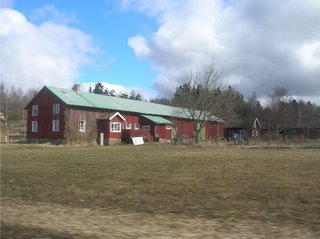

1 Comments:
hollister outlet
ralph lauren outlet
polo ralph kids
louis vuitton
air jordan 8
montblanc
vans sneakers
michael kors outlet
jordan retro 13
michael kors
asics shoes
ray ban sunglasses
cheap toms
louis vuitton handbags
ralph lauren polo
the north face outlet
michael kors handbags
kobe 11
cheap jordan shoes
coach factory outlet
insanity workout
michael kors outlet
michael kors handbags
louis vuitton outlet online
coach outlet store online clearances
marc jacobs handbags
cheap jerseys
michael kors canada
jordan 11
coach outlet canada
chenyingying2016713
Post a Comment
<< Home